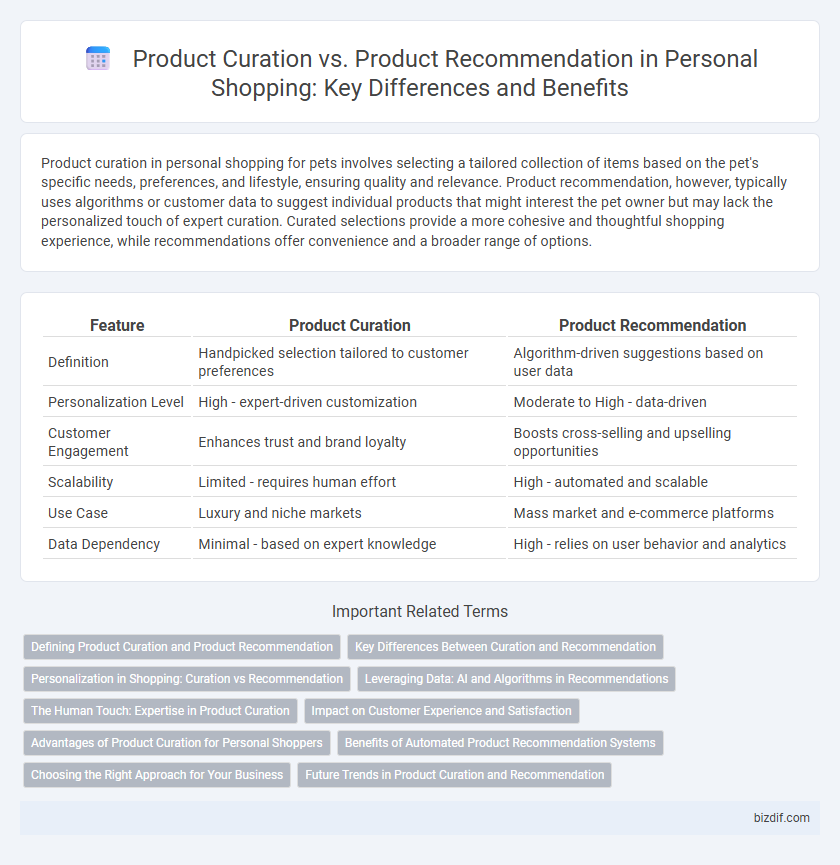Product curation in personal shopping for pets involves selecting a tailored collection of items based on the pet's specific needs, preferences, and lifestyle, ensuring quality and relevance. Product recommendation, however, typically uses algorithms or customer data to suggest individual products that might interest the pet owner but may lack the personalized touch of expert curation. Curated selections provide a more cohesive and thoughtful shopping experience, while recommendations offer convenience and a broader range of options.
Table of Comparison
| Feature | Product Curation | Product Recommendation |
|---|---|---|
| Definition | Handpicked selection tailored to customer preferences | Algorithm-driven suggestions based on user data |
| Personalization Level | High - expert-driven customization | Moderate to High - data-driven |
| Customer Engagement | Enhances trust and brand loyalty | Boosts cross-selling and upselling opportunities |
| Scalability | Limited - requires human effort | High - automated and scalable |
| Use Case | Luxury and niche markets | Mass market and e-commerce platforms |
| Data Dependency | Minimal - based on expert knowledge | High - relies on user behavior and analytics |
Defining Product Curation and Product Recommendation
Product curation involves a personalized selection of items tailored to a specific customer's tastes, preferences, and lifestyle, often handpicked by experts or algorithms to create a cohesive collection. Product recommendation utilizes data-driven techniques, leveraging browsing history, purchase patterns, and algorithms to suggest individual products that align with a user's behavior and interests. Both strategies enhance the personal shopping experience by providing more relevant and engaging product options.
Key Differences Between Curation and Recommendation
Product curation involves a deliberate selection of items based on expert knowledge, ensuring a cohesive and tailored collection that aligns with a specific style or need. Product recommendation uses algorithms and customer data to suggest items individually, aiming to predict what a user might prefer based on past behavior. The key difference lies in curation's human-driven, holistic approach versus recommendation's data-driven, personalized suggestions.
Personalization in Shopping: Curation vs Recommendation
Product curation in personal shopping involves handpicking items based on a deep understanding of individual preferences, lifestyle, and trends, offering a tailored but thoughtfully limited selection. Product recommendation leverages algorithms and customer data to suggest items dynamically, enhancing personalization through real-time analysis of browsing behavior and purchase history. Both methods elevate the shopping experience by providing targeted options, yet curation emphasizes expert-driven customization while recommendations rely on predictive analytics for personalized engagement.
Leveraging Data: AI and Algorithms in Recommendations
Product curation involves expert selection of items tailored to specific customer needs, while product recommendation uses AI and algorithms to analyze user data and behavior for personalized suggestions. Leveraging machine learning models and big data analytics enhances recommendation accuracy by predicting preferences based on purchase history, browsing patterns, and demographic information. Advanced algorithms enable dynamic, real-time updates to recommendation lists, optimizing customer engagement and increasing conversion rates in personal shopping experiences.
The Human Touch: Expertise in Product Curation
Product curation in personal shopping leverages expert knowledge to handpick items tailored to individual preferences, ensuring quality and relevance beyond algorithmic suggestions. Unlike automated product recommendations that rely on data patterns and user behavior, human curators apply nuanced understanding of style, trends, and customer needs. This human touch enhances the shopping experience by offering personalized, thoughtful selections that resonate deeply with customers.
Impact on Customer Experience and Satisfaction
Product curation enhances customer experience by offering a carefully selected range of items tailored to specific preferences, reducing decision fatigue and increasing satisfaction. In contrast, product recommendations leverage algorithms to suggest personalized options based on browsing behavior and purchase history, providing convenience and relevance. Combining both approaches optimizes personal shopping by delivering curated expertise alongside data-driven personalization, boosting overall satisfaction and engagement.
Advantages of Product Curation for Personal Shoppers
Product curation offers personal shoppers the advantage of a tailored selection process that filters products based on quality, trends, and client preferences, ensuring a more focused and relevant shopping experience. This approach reduces decision fatigue by presenting a refined, expertly vetted assortment rather than overwhelming customers with broad recommendations. Personalized product curation enhances client satisfaction and loyalty by consistently delivering unique, high-value items aligned with individual style and needs.
Benefits of Automated Product Recommendation Systems
Automated product recommendation systems enhance personal shopping by analyzing customer behavior and preferences to deliver highly relevant product suggestions, increasing conversion rates and customer satisfaction. These systems utilize machine learning algorithms to curate personalized shopping experiences, reducing the time customers spend searching and boosting average order value. Compared to manual curation, automated recommendations offer scalability and real-time updates, making them essential for modern e-commerce platforms.
Choosing the Right Approach for Your Business
Product curation involves selecting a focused range of products tailored to a specific audience, enhancing brand identity and streamlining customer choices, while product recommendation uses algorithms and data analysis to personalize suggestions based on individual user behavior. Businesses seeking to establish a strong brand presence and niche appeal benefit from curated collections, whereas companies aiming to increase customer engagement and sales through personalized experiences should leverage recommendation systems. Understanding your target market, resources, and technological capabilities is essential to choose the most effective approach for optimizing customer satisfaction and driving revenue.
Future Trends in Product Curation and Recommendation
Future trends in product curation and recommendation emphasize AI-driven personalization, leveraging machine learning algorithms to analyze consumer behavior and preferences for more accurate selections. Integration of augmented reality (AR) enhances virtual try-ons, creating immersive shopping experiences that elevate product recommendations. Data privacy and ethical AI use are becoming central, ensuring trust while delivering tailored recommendations through seamless omnichannel platforms.
Product curation vs Product recommendation Infographic

 bizdif.com
bizdif.com